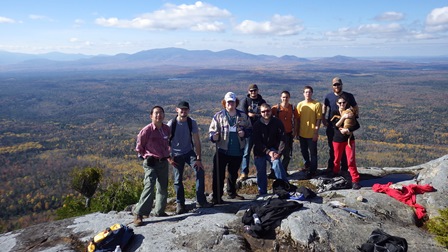A group of University of Maine at Presque Isle Environmental Studies and Sustainability (ESS) program faculty and students attended the 105th annual meeting of the New England Intercollegiate Geologic Conference (NEIGC), held at Millinocket Lake in the Katahdin region earlier this fall. NEIGC is a conference composed of three days of field trips led by regional experts to locations of geological and historical significance. It is designed to facilitate field-based interactions and dialogue between regional college students, faculty, and professional geologists.
Scott Belair, a recent UMPI ESS program graduate, and his wife, Leigh Belair, an UMPI adjunct instructor, hosted the UMPI group at their camp on Millinocket Lake. Students Andy Hunt, Henry Meyer, Mike Henderson, Angie Paul, Ray Kohutka, Jared Dickinson, Chris Staples, Gary Parent, and Dayton Maxcy were accompanied by ESS faulty Chunzeng Wang and David Putnam.
On the first day of the trip, Putnam led a group to South Branch Ponds in Baxter State Park. Most of the group walked around Lower South Branch Pond on a trip led by Tom Weddle, Maine Geological Survey, to explore a controversial feature described variously as a landslide deposit or an alluvial fan. Bob Johnston, Maine Geological Survey, led another group, including Jared Dickinson, up North Traveler Mountain to examine the rhyolite exposures and columnar joint structures. Wang took another group on a trip led by Adam Schoonmaker of Utica College and William Kidd of University at Albany to the area around Chesuncook Lake and Ripogenus Gorge to investigate Early Paleozoic stratigraphy and tectonics.
The next day, Wang took Kohutka, Dickinson, Maxcy, and Hunt on a climb up Roaring Brook to Chimney Pond in Baxter State Park to see Katahdin granite and glaciated landforms. It was guided by Bob Johnston of Maine Geological Survey. The low clouds fortuitously parted to afford the group a brief, but spectacular, view of the 1,500 foot, near vertical, glacially carved, granite headwall above Chimney Pond. Putnam and Parent chauffeured the remaining students on a trip to Katahdin Ironworks and Gulf Hagas. Angie Paul and Mike Henderson, Maliseet and Micmac tribal members, were able to collect natural red ochre at the old pit at Katahdin Ironworks. At Gulf Hagas, students were able to explore the scenic gorge, which was cut through a formation of sand and siltstones formed by submarine turbidites by high pressure/high velocity subglacial meltwater rich in abrasive sand. The gradient of the river through the gorge aligns with esker remnants above its head, showing how the sub-glacial drainage established its gradient by deposition above and incision through the bedrock below, to form the modern gorge.
On the third and final day of the trip, Putnam left the group to attend the Comer Abrupt Climate Change conference in Wisconsin, and Wang took the UMPI crew on the final field trip to Sugarloaf Mountain in the Shin Pond area. Led by Maine State Geologist Robert Marvinney, this trip focused on investigating an historic outcrop of fossils of brachiopod fauna that was more closely aligned with the “Celtic” fauna of the British Isles than with North American fauna of the same age. The discovery of the fossils in the 1960s, by then U.S. Geological Survey senior geologist Robert Neuman, supported the concept of an intervening Ordovician ocean—the Iapetus between the North American and the Europe-African continents at the time, and therefore the plate tectonic theory.
UMPI students have attended NEIGC every year for more than 18 years. Attending the hands-on geologic field trips provides students with important out-of-the-classroom learning opportunities and gives them the chance to meet faculty and students from many other colleges all over New England and beyond.
NEIGC began in 1901 with a field trip led by William Morris Davis to the terraces of the Westfield River in south-central Massachusetts, reported in Davis’ 1902 paper in American Journal of Science. The conference has met annually since that time, with exceptions during World Wars I and II, and a two-year gap during 1913 and 1914. The NEIGC may be the oldest “non-organization” in North America whose sole purpose is to organize and present field trips in areas of recent geologic mapping and topical studies.
